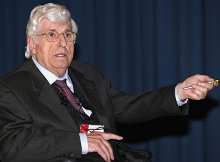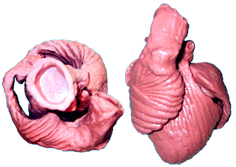Francisco Torrent-Guasp facts for kids
Quick facts for kids
Francisco Torrent-Guasp
|
|
|---|---|
 |
|
| Born | 1931 |
| Died | 2005 |
| Nationality | Spanish |
| Scientific career | |
| Fields | Cardiology |
Francisco ("Paco") Torrent-Guasp (born in Gandia, 1931 – died in Madrid, 2005) was a Spanish heart doctor, also known as a cardiologist. He spent his life studying how the human heart is built (its anatomy) and how it works (its physiology).
His amazing work led to him finding and describing something new: the ventricular myocardial band. This discovery changed how doctors and scientists understood the heart. You can find his work in important books about heart anatomy and surgery today.
About Paco
Paco Torrent-Guasp started learning about the heart when he was still in medical school at the University of Salamanca in Spain. His friends and family lovingly called him "Paco." In his fourth year, he began working with a professor named Gómez Oliveros. This is when he really started focusing on his lifelong passion: the heart's structure and how it functions. This interest led him to write his first book, El ciclo cardiaco (which means The Cardiac Cycle).
After finishing medical school, Paco became a family doctor in Dénia. But he didn't stop there! In his free time, he kept doing his own research. He worked independently, which meant he wasn't always part of the big science groups. He understood that what was taught in universities wasn't always the same as what happened in real patient care.
Paco published more books and shared his discoveries at many conferences. He often paid for these trips himself! In the 1970s, with help from the Juan March Foundation, he gave many talks at universities all over the world.
In 1972, he made his big discovery: the ventricular myocardial band. Because of this, he received the Miguel Servet (Michael Servetus) Prize in 1978. He was even nominated for the Nobel Prize in medicine that same year!
Paco Torrent-Guasp passed away suddenly in 2005 after giving a speech at a heart meeting in Madrid. His important discoveries continue to help students and doctors who study the heart's structure.
The Heart's Special Muscle Band
Many scientists before Paco had studied the heart's structure, like Andreas Vesalius and William Harvey. We know that human and bird hearts have four parts: two upper chambers called atria and two lower chambers called ventricles. The heart's muscle fibers are woven together in many layers.
For a long time, people tried to figure out how blood moves through the body. But not many paid close attention to the overall design of the heart muscle itself. They didn't focus on how the muscle fibers were layered and how this affected blood flow.
Paco Torrent-Guasp spent countless hours dissecting (carefully taking apart) animal hearts in his lab in Dénia. He also compared the hearts of different vertebrates (animals with backbones) and even annelids (like earthworms). From these dissections, he realized something amazing. He saw that the heart's lower chambers (the ventricles) are actually one long, continuous muscle band. This band folds up like a spiral during a baby's development before birth. This folding creates a wall (called the septum) that divides the single chamber into two separate ventricles, right before birth.
Paco then looked closely at how this structure (anatomy) affects how the heart works (physiology). Most people thought the heart's motion was simple: it actively squeezes (systole) and then passively relaxes (diastole). But Paco's model of the ventricular myocardial band suggested something different. He believed that the heart actively pulls blood in during relaxation (diastole) through a special kind of muscle contraction. So, it's not just passive relaxation; there's an active pull that helps the heart fill with blood.
How Paco's Discovery Helps Doctors
Paco's ideas about the ventricular myocardial band have opened up new ways to think about heart surgery. Especially for people with a condition called systolic heart failure. This is when the heart's main pumping chambers (ventricles) become weak and enlarged.
Doctors often try to improve the shape of these enlarged hearts. One old procedure, called a ventriculotomy, involved removing some extra muscle tissue from inside the heart. However, using Paco's model, doctors Suma and Burkberg found a better way. Instead of cutting out muscle, they used a special patch (called a Dacron patch). They placed this patch along the heart's muscle fibers. This helped reshape the heart's cavity from an abnormal round shape to a more normal oval shape. This improved how much blood the heart could pump with each beat.
This new procedure, called septal anterior ventricular exclusion, was named "pacopexia" in honor of Paco Torrent-Guasp. It shows how his deep understanding of the heart's structure can lead to real improvements in treating heart conditions.
See also
 In Spanish: Paco Torrent Guasp para niños
In Spanish: Paco Torrent Guasp para niños


